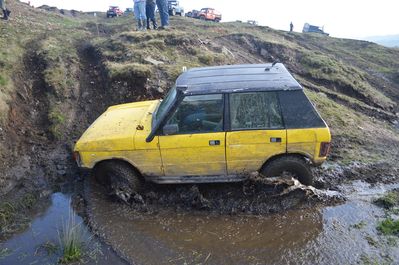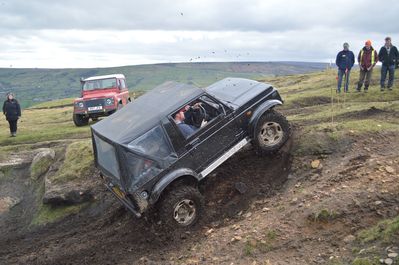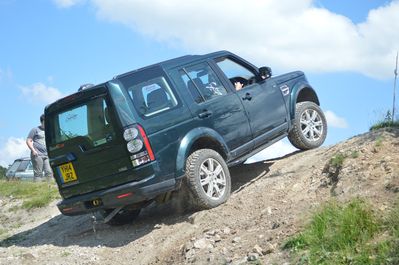Anybody got a portable lambda probe I can stick up me pipe?
Anybody got a portable lambda probe I can stick up me pipe?
Since I now have Megajolt  I need to adjust the mixture. It was always rich, but that used to be needed to keep it running!
I need to adjust the mixture. It was always rich, but that used to be needed to keep it running!
It's a 3.9 hotwire EFI, but with no lambda sensors or cats, so (if I am not mistaken) it is possible to adjust the mixture with the trim pot on the AFM. Trouble is the idle-speed maintenance kicks in so it's difficult to see if my changes are having any effect.
So I wondered if anybody has a lambda sensor wired up for use up the pipe?
Roger
Just occurred to me that if I use the "block the bypass hose" trick (that is used for base idle setting) I could probably manage to do it by ear/nose, so I'll try that tomorrow. But I would still like lambda confirmation if poss.
It's a 3.9 hotwire EFI, but with no lambda sensors or cats, so (if I am not mistaken) it is possible to adjust the mixture with the trim pot on the AFM. Trouble is the idle-speed maintenance kicks in so it's difficult to see if my changes are having any effect.
So I wondered if anybody has a lambda sensor wired up for use up the pipe?
Roger
Just occurred to me that if I use the "block the bypass hose" trick (that is used for base idle setting) I could probably manage to do it by ear/nose, so I'll try that tomorrow. But I would still like lambda confirmation if poss.
- davew
- Chairman
- Posts: 2242
- Joined: Fri Jan 05, 2007 8:54 pm
- Location: Knaresborough
- Full Name: Dave White
Don't have a probe but you could always fit a lambda sensor to the exhaust ?
Get a suitable nut from your local bolt and nut supplier, drill a suitable sized hole in the exhaust, weld the nut to the exhaust and screw the lambda sensor into it. Off the top of my head I think the thread is M18 fine (M18x1.25). Get a half (locking) nut if you can, otherwise just cut the nut in half and you get 2 for the price of one get the lambda sensor first and take it to the bolt and nut place with you to make sure you get the right thread. Fit the sensor as near to the manifold as you can on one side, making sure it's easily accessible.
get the lambda sensor first and take it to the bolt and nut place with you to make sure you get the right thread. Fit the sensor as near to the manifold as you can on one side, making sure it's easily accessible.
You can pick up a few lambda sensors at the local scrap dealers for a few quid (best to get more than one so you can compare readings from each to start with - old lambda sensors can give incorrect readings. DON'T use Land Rover lambdas, they use titania semsors that are so narrow band they are unusable.They also require a voltage source whereas zirconia ones generate their own voltage.
Lambda sensors come in a variety of flavours, identifiable by the number of wires. Anything between 1 and 4 wires is good - I use 4 wire sensors. 4 wire sensors are heated so they give an accurate reading quicker and are more stable. Go for zirconia sensors, these use a combination of black, blue, white and grey wires. The heater circuit uses whichever 2 wires are the same colour (normally white or black) and just need one wire to 12v ignition and the other to earth.
The signal wires will be either black for the signal and grey for the earth or blue for the signal and white for the earth. A volt meter between the signal and earth wire will give a reading between 0.1v and 0.9v depending on the mixture - 0.9v too rich, 0.1v too weak. The ideal mixture will give a reading of 0.5v. Being "narrow band" the voltage will change rapidly as you move away from the ideal mixture.
It's worth trying a few different sensors and comparing the results to rule out contaminated sensors that may give spurious readings. Go for cleasn sensors over carbon fouled ones too. Always check the lambda results against other indicators (smell, idle smoothness etc...) just in case you get a bad sensor - maybe even run it to a firendly MOT tester and ask them to do an emissions test to verify it afterwards. If you leave the sensor in teh exhaust, make sure the heater circuit is powered on with the ignition as it helps top it getting fouled up.
If you want to splash out, a new "universal" bosch 4 wire lambda will set you back about £45.
I use
http://www.lambdasensor.com/
for new stuff and as a reference for wiring and so on.
Get a suitable nut from your local bolt and nut supplier, drill a suitable sized hole in the exhaust, weld the nut to the exhaust and screw the lambda sensor into it. Off the top of my head I think the thread is M18 fine (M18x1.25). Get a half (locking) nut if you can, otherwise just cut the nut in half and you get 2 for the price of one
You can pick up a few lambda sensors at the local scrap dealers for a few quid (best to get more than one so you can compare readings from each to start with - old lambda sensors can give incorrect readings. DON'T use Land Rover lambdas, they use titania semsors that are so narrow band they are unusable.They also require a voltage source whereas zirconia ones generate their own voltage.
Lambda sensors come in a variety of flavours, identifiable by the number of wires. Anything between 1 and 4 wires is good - I use 4 wire sensors. 4 wire sensors are heated so they give an accurate reading quicker and are more stable. Go for zirconia sensors, these use a combination of black, blue, white and grey wires. The heater circuit uses whichever 2 wires are the same colour (normally white or black) and just need one wire to 12v ignition and the other to earth.
The signal wires will be either black for the signal and grey for the earth or blue for the signal and white for the earth. A volt meter between the signal and earth wire will give a reading between 0.1v and 0.9v depending on the mixture - 0.9v too rich, 0.1v too weak. The ideal mixture will give a reading of 0.5v. Being "narrow band" the voltage will change rapidly as you move away from the ideal mixture.
It's worth trying a few different sensors and comparing the results to rule out contaminated sensors that may give spurious readings. Go for cleasn sensors over carbon fouled ones too. Always check the lambda results against other indicators (smell, idle smoothness etc...) just in case you get a bad sensor - maybe even run it to a firendly MOT tester and ask them to do an emissions test to verify it afterwards. If you leave the sensor in teh exhaust, make sure the heater circuit is powered on with the ignition as it helps top it getting fouled up.
If you want to splash out, a new "universal" bosch 4 wire lambda will set you back about £45.
I use
http://www.lambdasensor.com/
for new stuff and as a reference for wiring and so on.
Dave - many thanks for the full and informative answer - you should write a book! 
I have taken your suggestion and gone one step further: I read that the 14CUX is already loaded with various maps, and the cat map in particular will used Lambda inputs (if present) to auto tune the mixture, so I have got two new sensors on the way - they have one black, one grey and two white wires, so I assume they are the good ones! I got them off off eBay and a couple of bosses too. It is my intention to wire them in permanently and release the full potency of all that eighties technology
The reason I went for two is that I also read that if using a map which expects Lambda inputs, then the ECU will throw a fault if it only sees one - or if one is unresponsive etc. and go into limp-home mode.
Other things I am considering are the AFM (faulty?), the tach signal from Megajolt (unlikely, but feasible that the signal is 'bouncing' and telling the ECU that the engine is running faster than it is), a faulty/worn injector (or eight), or the fuel pressure too high. I guess the injectors may be the most likely, but also the hardest to assess. Anyway - if the Lambdas work, then the ECU should be able to compensate for any of those problems as long as they are not too bad...
Wish me luck - I'll let you know how I get on
I have taken your suggestion and gone one step further: I read that the 14CUX is already loaded with various maps, and the cat map in particular will used Lambda inputs (if present) to auto tune the mixture, so I have got two new sensors on the way - they have one black, one grey and two white wires, so I assume they are the good ones! I got them off off eBay and a couple of bosses too. It is my intention to wire them in permanently and release the full potency of all that eighties technology
The reason I went for two is that I also read that if using a map which expects Lambda inputs, then the ECU will throw a fault if it only sees one - or if one is unresponsive etc. and go into limp-home mode.
Other things I am considering are the AFM (faulty?), the tach signal from Megajolt (unlikely, but feasible that the signal is 'bouncing' and telling the ECU that the engine is running faster than it is), a faulty/worn injector (or eight), or the fuel pressure too high. I guess the injectors may be the most likely, but also the hardest to assess. Anyway - if the Lambdas work, then the ECU should be able to compensate for any of those problems as long as they are not too bad...
Wish me luck - I'll let you know how I get on
- davew
- Chairman
- Posts: 2242
- Joined: Fri Jan 05, 2007 8:54 pm
- Location: Knaresborough
- Full Name: Dave White
I'm pretty sure the 14CUX uses titania lambdas, not the zirconia ones you've ordered  The ECU won't be able to get a sensible reading from them.
The ECU won't be able to get a sensible reading from them.
With titania sensors you supply them with a reference voltage and they return a modified version of that voltage. Zirconia use a chemical reaction and create their own voltage which makes them simpler to use and test.
Dave, it has been said many times before and you are correct, I should get out more
With titania sensors you supply them with a reference voltage and they return a modified version of that voltage. Zirconia use a chemical reaction and create their own voltage which makes them simpler to use and test.
Dave, it has been said many times before and you are correct, I should get out more
- davew
- Chairman
- Posts: 2242
- Joined: Fri Jan 05, 2007 8:54 pm
- Location: Knaresborough
- Full Name: Dave White
As far as the problem you are having is concerned...
It could be the signal from the megajolt, the last part of the normal ECU input uses resistive wire to reduce spikes so it's important, if you're using a feed from the coil packs, to retain the original wire.
I'd have expected problems with a weak mixture more than a rich mixture if it was a triggering problem but I suppose it could be getting false triggers. In theory you should be able to attach a rev counter to the injector feed on one bank and get some form of sensible reading. It'd need to be a modern rev counter though as the older ones expect a big spike from the coil. A TD5 rev counter works... That would possible give you a way of comparing what the ECU thinks is happening to what the megajolt thinks is happening RPM wise i think the standard ECU fires each bank of injectors twice per full cycle in which case it would show one quarter of the actual rpm unless you can tell the rev counter it's a 2 cylinder engine.
Check or just replace the coolant temperature sender that the ECU uses, it's located at the front of the inlet manifold near the distributor and has a 2 pin connector (it looks like a 9th injector at a glance). A good number of fuelling problems are caused by that sensor giving incorrect readings and fooling the ECU into thinking the engine is colder than it is.
Check the throttle position sensor is set up correctly as per the manual, the ECU uses the TPS for one of it's primary fuelling calculations so having it set wrong can be a problem.
The AFM is the final link in the chain for calculating fuelling and, as it measures the air and density of air flowing into the engine it is pretty important.
Another, often overlooked, cause of overfuelling at low revs is the fuel pressure. If the return pipe from the regulator is blocked or restricted the fuel rail pressure will be too high and the engine will overfuel, it will normally go really well at high speeds/rpm though ! If that rings any bells take the return pipe off and check the rubber sections, the inner wall often collapses, partially or fully blocking the pipe. You should be able to blow down the pipe fairly easily from the engine end and hear the fuel in the tank bubbling.
It could be the signal from the megajolt, the last part of the normal ECU input uses resistive wire to reduce spikes so it's important, if you're using a feed from the coil packs, to retain the original wire.
I'd have expected problems with a weak mixture more than a rich mixture if it was a triggering problem but I suppose it could be getting false triggers. In theory you should be able to attach a rev counter to the injector feed on one bank and get some form of sensible reading. It'd need to be a modern rev counter though as the older ones expect a big spike from the coil. A TD5 rev counter works... That would possible give you a way of comparing what the ECU thinks is happening to what the megajolt thinks is happening RPM wise i think the standard ECU fires each bank of injectors twice per full cycle in which case it would show one quarter of the actual rpm unless you can tell the rev counter it's a 2 cylinder engine.
Check or just replace the coolant temperature sender that the ECU uses, it's located at the front of the inlet manifold near the distributor and has a 2 pin connector (it looks like a 9th injector at a glance). A good number of fuelling problems are caused by that sensor giving incorrect readings and fooling the ECU into thinking the engine is colder than it is.
Check the throttle position sensor is set up correctly as per the manual, the ECU uses the TPS for one of it's primary fuelling calculations so having it set wrong can be a problem.
The AFM is the final link in the chain for calculating fuelling and, as it measures the air and density of air flowing into the engine it is pretty important.
Another, often overlooked, cause of overfuelling at low revs is the fuel pressure. If the return pipe from the regulator is blocked or restricted the fuel rail pressure will be too high and the engine will overfuel, it will normally go really well at high speeds/rpm though ! If that rings any bells take the return pipe off and check the rubber sections, the inner wall often collapses, partially or fully blocking the pipe. You should be able to blow down the pipe fairly easily from the engine end and hear the fuel in the tank bubbling.
davew wrote:I'm pretty sure the 14CUX uses titania lambdas, not the zirconia ones you've orderedThe ECU won't be able to get a sensible reading from them.
Bugger!
So now I have some options to consider:
1. Stick them straight back on eBay and buy some Titania (wasn't that where the fish-men lived in Stingray?) ones.
2. Use the Zirconia ones, but modify the signal with a little electronic trickery. Perhaps not such a good idea since the Zirconia ones need a reference sample of air and so would not like immersion. I guess this is the reason that LR use Titania, which requires no such sample and can hence be totally sealed.
3. Use one just to give me a visual cue and adjust the mixture manually with the trim-pot in the AFM, and flog the other. I think that this is the one I will go for...
Using original wire? Yes - got one thing right thendavew wrote:As far as the problem you are having is concerned...
It could be the signal from the megajolt, the last part of the normal ECU input uses resistive wire to reduce spikes so it's important, if you're using a feed from the coil packs, to retain the original wire.
Coolant sensor resistance (cold, warm and hot) correct? Yesdavew wrote:Check or just replace the coolant temperature sender that the ECU uses
- The pipework can be assumed good since I have replaced the whole lot with correct-specc'd flexible and used the return (disconnected at the tank and fed into a gerry can) to extract that 'fuel' from the tank last week - it flows welldavew wrote:Another, often overlooked, cause of overfuelling at low revs is the fuel pressure.... ...'If the return pipe from the regulator is blocked or restricted'...
Another option is the pressure regulator on the back of the fuel rail - it could be faulty or it could be the vacuum reference that it uses for example, so I replaced the vacuum pipework from the back of the plenum just in case and checked all over the rest and now that is all good.
I actually found a massive leak in the pipework to the heater vacuum reservoir which definitely makes a difference to the running and could be the reason it was adjusted to run rich in the first place...
The rest of your suggestions are still to be investigated...
Once again - thanks for the help on this.
With regard to "getting out more" - what about getting out could be more fun than this?
Roger
P.S. Dave - you don't happen to have a fairly standard ignition map do you? The ones I am seeing on the net are a bit difficult to assess when I can't drive it on the road and some of them are a little 'extreme' I think. Actually a map of the original dizzy curves would be a nice start point - I wonder if I can find one of those...
- davew
- Chairman
- Posts: 2242
- Joined: Fri Jan 05, 2007 8:54 pm
- Location: Knaresborough
- Full Name: Dave White
This is a screen grab of the ignition map I've used on the last couple I've done.
I've also attached a .vex file containing the data, not sure if you can use that ?
I've also attached a .vex file containing the data, not sure if you can use that ?
- Attachments
-
- advTable1_200808010951.vex
- MegaTune exported ignition map
- (1.66 KiB) Downloaded 1216 times
Now THAT looks more like it - although I think I'll knock the 6000rpm bucket down to zeros to create a rev limiter zone - I don't think my motor would be up for 6000rpm...
I'll try that this evening.
Cheers
Roger
edited to add:
Well I now have your map on my MJ and it's certainly a vast improvement on anything I have tried so far Thanks!
Thanks!
I had to make some mods since MJ only has a 10x10 map, and I also smoothed out some of the lumps and dips which I assume are for a specific engine requirements, but it's a lovely map compared to most I have seen.
The immediately noticeable difference is the pickup off idle which is much sharper and tolerant of stupidly quick throttle movements than before. I also managed to lean it off a load - unfortunately now that I have done that I can see that it burns oil Hopefully not enough to fail the MoT though...
Hopefully not enough to fail the MoT though...
I think I may try one of my lambda sensors this weekend if I get time and just sell the other one. Titania ones seem to fetch a bit of a premium so I don't think I'll be going down the originally planned route. Instead if I can do the mixture using one of these I will leave it at that I think.
Once again thanks for the help Dave.
Roger
I'll try that this evening.
Cheers
Roger
edited to add:
Well I now have your map on my MJ and it's certainly a vast improvement on anything I have tried so far
I had to make some mods since MJ only has a 10x10 map, and I also smoothed out some of the lumps and dips which I assume are for a specific engine requirements, but it's a lovely map compared to most I have seen.
The immediately noticeable difference is the pickup off idle which is much sharper and tolerant of stupidly quick throttle movements than before. I also managed to lean it off a load - unfortunately now that I have done that I can see that it burns oil
I think I may try one of my lambda sensors this weekend if I get time and just sell the other one. Titania ones seem to fetch a bit of a premium so I don't think I'll be going down the originally planned route. Instead if I can do the mixture using one of these I will leave it at that I think.
Once again thanks for the help Dave.
Roger
Who is online
Users browsing this forum: No registered users and 11 guests




